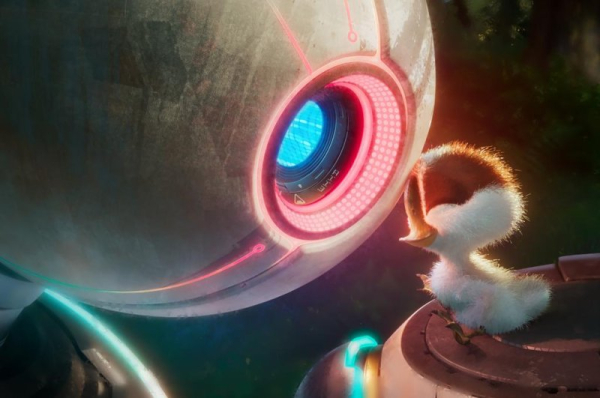Movie review: ‘Wild Robot’ delivers more emotional robot dreams

1 of 5 | Roz (L) takes care of Brightbill. Photo courtesy of Universal Pictures/Dreamworks Animation
Robots in film tend to be vehicles for exploring humanity. In animation particularly, The Wild Robot joins The Iron Giant and Wall-E as a poignant tale of human growth through the eyes of a sentient robot.
Rossum-7134, or Roz (Lupito Nyong’o) for short, crashes on a future Earth. In the forest with only animals around, Roz tries to adapt her task as a human assistant to nature. Advertisement
Roz deciphers animal language so the film can present spoken dialogue as English. When Roz accidentally crushes a goose nest, she takes it upon herself to raise the surviving gosling, which she names Brightbill.
Many films, animated or otherwise, deal with chosen families when something happens to the one from which the characters were born. Roz’s robot programming adds a layer of a computer trying to analyze natural, essentially human, behavior as if it were data. Advertisement
Roz needs to teach Brightbill how to swim and fly in time for him to migrate for the winter. Not only does Roz try to teach from an outside perspective something that should be innate for a bird, but she has trouble processing why this is challenging for Brightbill.
Science-fiction stories from Terminator 2 to Star Trek have explored trying to explain love to a data-based computer. Roz translating emotional processes into technical terms does a sly job of exposing human needs and foibles.
Brightbill is an outcast both for being a runt and for having a robot “mother” instead of a mother goose. His rejection of Roz mirrors teenage rebellion against parents.
The Wild Robot gets even more complex the further along the plot goes, introducing complications of a future human society and robots without Roz’s exposure to biological life. The film brings all of these themes to a moving and resonant conclusion.
To do so in a family-friendly movie, the adaptation of Peter Brown’s book must simplify the steps along the way. As such, the film can feel episodic, only exploring moments like Brightbill’s swimming and flying lessons or his exposure to other robots long enough to observe a moral and then move onto the next scene. Advertisement
The first part of the film covers an entire year from Brightbill’s birth to winter migration, so time jumps can be jarring, especially when Brightbill suddenly goes from child to teenager.
This could also play more smoothly upon repeat viewings, because by the end, it is entirely clear how vital every component along the way is to building these themes.
In addition to parental struggles and chosen family, The Wild Robot also deals with expressing oneself to resolve unfinished business, the role of kindness in survival and essentially what is a soul?
The characters take a humorous approach to death, especially a family of possums for whom playing dead is a survival skill. Yet, the death of Brightbill’s mother and sibling eggs is never made light.
Furthermore, it pays off in the theme that nothing Roz does will prevent death or danger. She tries her best, but even if she succeeds in teaching Brightbill to fly, there’s no guarantee he’ll make it to warmer climates with the other geese.
It is a bittersweet message, as all parents can only hope they’ve prepared their children enough for life. Advertisement
The animation is beautiful, rendering the background essentially photoreal, with some glimpses of landmarks in their diminished states. Animals have a watercolor effect with fuzzy fur and feathers in closeups.
As the seasons change, those environments appear diversely from natural storms to unnatural attacks lighting up the forest.
The most devastatingly emotional robot movie remains Robot Dreams, but there’s room for The Wild Robot, too. It speaks to a younger audience than Robot Dreams but offers life lessons that older viewers will recognize and relate to as well.
Fred Topel, who attended film school at Ithaca College, is a UPI entertainment writer based in Los Angeles. He has been a professional film critic since 1999, a Rotten Tomatoes critic since 2001, and a member of the Television Critics Association since 2012 and the Critics Choice Association since 2023. Read more of his work in Entertainment.
